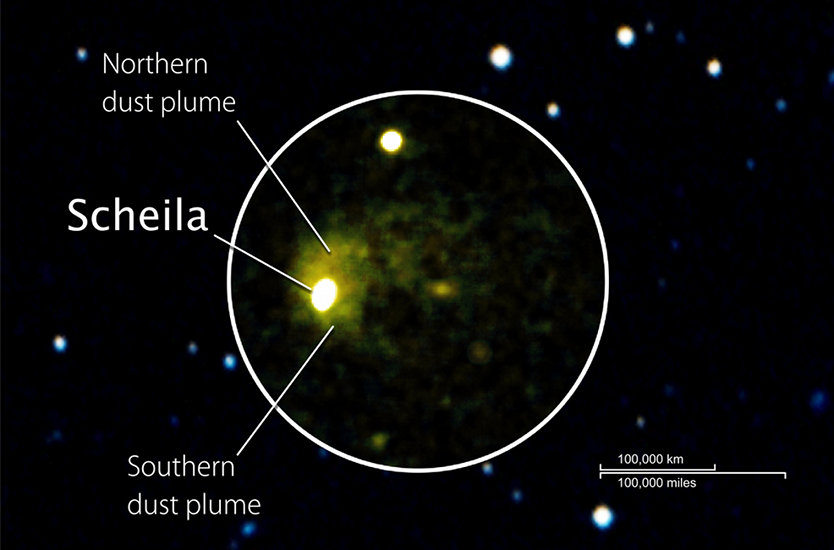
 Credit: NASA/Swift/DSS/D. Bodewits (UMD)
Credit: NASA/Swift/DSS/D. Bodewits (UMD)
Busted
On December 11, 2010, an otherwise nondescript asteroid named Scheila brightened suddenly. In addition, the asteroid showed evidence of plume-like jets of gas emanating from its surface. It was almost as if this asteroid was transforming itself into a comet. Comets and asteroids are two separate categories of objects, of course: comets are huge interplanetary snowballs, while asteroids are giant rocks hurtling through space. But we know now that some asteroids apparently have substantial pockets of ice and other volatile materials below the surface, and in rare instances this material can become exposed and blow off the surface when heated by the sun. To see if this was happening, astronomers trained the Ultraviolet and Optical Telescope (UVOT) aboard the Swift spacecraft observatory at Scheila, and, a few days later, the cameras on the Hubble Space Telescope. The UVOT image of Scheila is shown above. The image of the comet was overexposed to reveal faint dust plumes in the optical and UV image. A spectrum of the asteroid obtained by the UVOT showed no evidence of water, indicating that the ejected material was not due to exposed water ice. The combined Hubble and Swift observations show that the December 11 brightening was most probably due to an 11,000 mile per hour collision between a small asteroid and Scheila. Images of craters on asteroids give mute testimony to the occurrence of ancient collisions; this is the first time such a young collision has been seen in near real-time. A deeper impact?
Published: May 9, 2011
<
HEA Dictionary ● Archive
● Search HEAPOW
● Other Languages
● HEAPOW on Facebook
● Download all Images
● Education ● HEAD
>

Each week the HEASARC
brings you new, exciting and beautiful images from X-ray and Gamma ray
astronomy. Check back each week and be sure to check out the HEAPOW archive!
Page Author: Dr. Michael F. Corcoran
Last modified Tuesday, 27-Feb-2024 10:08:22 EST


